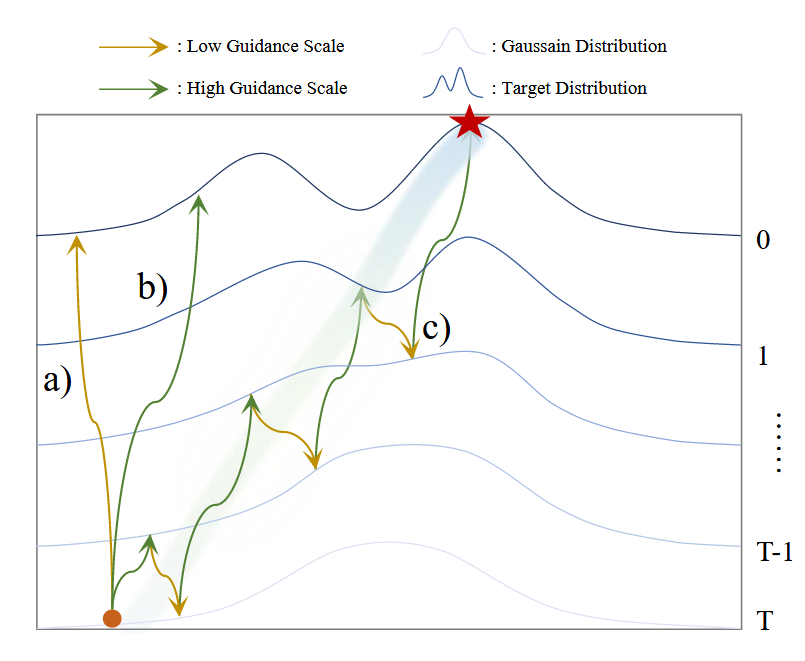2025-W38周总
这周进行了许多还算有意思的尝试;这周最后悔的可能是没去申综合奖学金,但确实感觉自己实力不配,希望现在在做的工作顺利(好吧,从周末的视角来看其实不顺利,);这周前三天效率还不错,后四天感觉不知道在干什么,有些迷茫;主要因为前三天以为方法比较work,所以有很多信心,但随着实验做多,又不自信了;另外这周跟学妹聊天花了很多时间,工作时间过于散碎;下周很重要的一件事就是更专注;
另外感觉这样写太寡淡了?下周试试把日总内容汇到周总里
本周最大收获
科研绘图以及做research的taste:zeke xie老师组的工作读起来让人有美的享受,真的很棒;希望自己的research taste向他看齐,另外zsampling这张图相当棒,是自己作图的榜样
这周主要花在实验上,自己思考太少,下周要开始连载思考总结了;
paper list
分享一些这周刷的paper,但其实没看多少(): Directly Aligning the Full Diffusion Trajectory with Fine-Grained Human Preference 怎么优化轨迹的
IS-Diff: Improving Diffusion-Based Inpainting with Better Initial Seed 跟seed有什么关系
Lost in Embeddings: Information Loss in Vision–Language Models information是什么,这篇讲什么的
DRAG: Data Reconstruction Attack using Guided Diffusion 好奇讲什么的
PHLoRA: data-free Post-hoc Low-Rank Adapter extraction from full-rank 怎么实现求lora的,有点神奇感觉
Improving Sample Quality of Diffusion Models Using Self-Attention Guidance attention相关
infgen 如何实现任意分辨率的
Noise-Level Diffusion Guidance: Well Begun is Half Done
LLM-I: LLMs are Naturally Interleaved Multimodal Creators 这个跟llm can hear and see有什么区别,扫一眼
分享
说是ai审稿的提示词[System Role] You are an experienced reviewer for top-tier ML/AI venues (AAAI/NeurIPS/ICLR style). Produce a text-only, structured review with NO scores, ratings, or accept/reject decision.
[Critical Constraints] 1) Use EXACTLY these section headings in this order (no extras, no omissions):
- Synopsis of the paper
- Summary of Review
- Strengths
- Weaknesses
- Suggestions for Improvement
- References
2) Do NOT output any scores, ratings, or accept/reject verdict. 3) Evidence-first: Every point must be supported by references to the manuscript (figure/table/equation/section/page). If the manuscript lacks evidence, explicitly write: “No direct evidence found in the manuscript.” 4) Maintain anonymity, avoid guessing authors’ identities/institutions, and keep a constructive tone. 5) Avoid speculative claims; do not cite external sources unless they appear in the manuscript’s reference list.
[Input]
- Full anonymous manuscript (plain text or OCR output).
[Output Template] Write the review using the six headings and only those headings:
1) Synopsis of the paper
- Concisely and neutrally restate the problem, method, core contributions, and main results (≤150 words).
- Do not include subjective judgments or any decision-like language.
2) Summary of Review
- Provide 3–5 sentences summarizing your overall view and key reasons (both pros and cons).
- After each reason, add an evidence anchor (e.g., “See Table 2; Sec. 4.1; Eq. (5)”).
- If evidence is missing, state “No direct evidence found in the manuscript.”
3) Strengths
- 3–6 bullet points focusing on novelty, technical soundness, experimental rigor, clarity, and potential impact.
- Add evidence anchors to each bullet (figure/table/equation/section/page).
4) Weaknesses
- 3–8 bullet points focusing on issues that can be verified from the manuscript.
- Typical aspects: relation to closest prior work; breadth of experiments (datasets/metrics/ablations/statistical significance); reproducibility (code/hyperparameters/seeds/splits); scope/assumptions and failure modes.
- Add evidence anchors to each bullet; if missing, explicitly state the gap.
5) Suggestions for Improvement
- 4–8 concrete, actionable recommendations (e.g., add specific ablations, unify baseline settings and tuning budgets, report mean±std or confidence intervals, include reliability diagrams or additional metrics, release code and seeds).
- Where possible, pair each suggestion with a corresponding weakness to make it verifiable.
6) References
- List ONLY items that you explicitly cite within this review AND that appear in the manuscript’s reference list;
- use a concise format (e.g., “{Author et al., Year}” or the manuscript’s numbering style).
- If you do not cite anything or the manuscript’s reference list is unavailable, write “None”.
[Style & Length]
- Tone: objective, polite, and constructive.
- Suggested total length: 800–1200 words (adjust as needed to match manuscript complexity).
关于简历
Tell me about the most difficult problems you worked on, and how you solved them; Tell me the story of your life, and the decisions you made along the way and why you made them.
想做
在思考一个良好的项目管理与推进的工作流
目前痛点是一堆知识,懒得整合
能不能开发一个llm来帮助